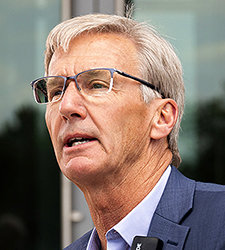It was spring 2020, the beginning of the pandemic. City and state governments across the country were implementing stay-at-home orders. So much was unknown about COVID-19’s dangers or its trajectory. And yet, government responses to the crisis were already drawing partisan judgments.
On April 17, barely a month into emergency orders restricting access to public spaces, then-President Donald Trump tweeted “Liberate Minnesota,” a message meant to give support to protesters who thought the state had over-restricted business, education and social life in the state.

He did the whole song pic.twitter.com/M0ZWPOvCmN
— Washington Post TikTok Guy
(@davejorgenson) May 6, 2020
Minnesota was on the “drop dead” side in a sequence that included Mississippi, Missouri, Montana and Nebraska, all because the state hadn’t properly closed down public places, according to the poster. And while some Minnesotans pushed back at justinpollack7, the University of Washington-based Institute for Health Metrics and Evaluation also did not consider Minnesota to be among the states that had implemented non-essential services closures, weeks after the state’s initial lockdown order of March 17.
The unnamed target of both social media messages was Gov. Tim Walz, who 15 months into his first term as governor was thrust into the middle of an unprecedented public health emergency caused by a virus that was previously unknown.

GOP nominee Scott Jensen was an early critic of pandemic responses, gaining a national audience when he claimed doctors and hospitals were categorizing deaths as COVID-related as a way of getting higher reimbursements from insurance and government.

- In the U.S., 68% of those who support Democrats said the country has done a good job of dealing with the outbreak while 45% of those who support Republicans said so.
- Some 64 percent of respondents who support Democrats said getting the vaccine is “very important to be a good member of society,” while 20% of respondents who support Republicans said so.
- On whether the country is more united after the pandemic than before, 23% of Democrats and just 10% of Republicans said it is.
According to Pew, the U.S. leads the 19 nations surveyed in saying the pandemic increased division and were most likely to say the response highlighted the failings of the political system.
The nation’s COVID-19 response was led not by the federal government but by the states. The patchwork of state responses might not have been the most efficient, but it inadvertently created a laboratory for how well different interventions balanced health needs with the economy and social well-being.
“States learned from one another over time about what policies worked most and least effectively in terms of containing the virus while minimizing the negative effects of lockdown strategies on businesses and children,” wrote a trio of economists in “A Final Report Card on the States’ Response to COVID-19.”
How did the response play out in Minnesota?
- March 13, 2020: Walz declared a state of emergency the same day President Trump issued an emergency declaration for the U.S.
- March 15, 2020: Walz closed schools.
- March 17, 2020: Walz closed bars and restaurants.
- March 25, 2020: Walz issued the first stay-at-home order, which would be loosened over the spring/summer.
- May 18, 2020: Walz lifted the stay-at-home order.
- July 22, 2020: Walz issued an indoor mask mandate.
- Nov. 18, 2020: Walz closed bars, restaurants, gyms, etc., as COVID hospitalizations and deaths spiked.
- July 1, 2021: Walz’s emergency powers ended.
In the two years after the March 2020 outbreak, there have been several attempts to compare and contrast the various interventions states used during the pandemic. How does Minnesota measure up to other states? It depends on who you ask and what measurements they use to rank outcomes.
Here is a summary of some of those analyses:
Politico
The news organization has done one of the most comprehensive examinations of data on health outcomes, the economy, social well-being and education. Its State Pandemic Scorecard published in December looked at how the states balanced those factors.
“There was no optimal way to make those choices, and we’re still debating them,” the authors concluded. “But nearly two years after the first cases of COVID-19 were detected in the United States, we are beginning to get enough data to start assessing the implications of those policy choices.”
“Every choice came with negative consequences, some known ahead of time, some only discovered or appreciated months later,” they wrote.
With 100 being the maximum score in the four categories, Nebraska placed first with an average of 73. But how it reached the top demonstrates the differences in state priorities. Nebraska scored 56 in health outcomes, 90 in economy, 49 in social well-being and 95 in education. (Social well-being used metrics on food insecurity, households’ economic hardship and violent crime.)
“States that imposed more restrictions such as stay-at-home orders and mask requirements did experience lower rates of death and hospitalizations,” Politico wrote. “But they also tended to have worse economic outcomes.”
Minnesota’s average score was 63, ranking it 5th overall. But again, it had a high score on health outcomes (8th among states) and education (13th) but low scores on economy (31st) and social well-being (28th). Still, not doing especially well or especially poorly led the authors to single out Minnesota for perhaps striking a balance.
“For his part, Walz said he knew that shutdown orders and other restrictions would be unpopular, but he still made the call to impose them,” Politico wrote. That allowed Walz to repeat one of his favorite lines during the depth of the pandemic.
“I got to the point where I was saying, ‘Please, just wear the mask so you live long enough to vote against me,’” he told the publication. When Walz issued a mandatory indoor mask mandate on July 22, 2020, it came after more than half the other governors had already so.
The scorecard also noted a partisan difference in pandemic responses: Fourteen of the 15 states that scored highest in health outcomes voted for President Joe Biden; eight of the top 10 states in the economic category voted for former-President Donald Trump and had Republican governors.
Committee to Unleash Prosperity and the University of Chicago
Conservatives might be more likely to embrace “A Final Report Card On The States’ Response to COVID-19,” an analysis prepared by University of Chicago economist Casey Mulligan and two economists from the Committee to Unleash Prosperity, Stephen Moore and Phil Kerpen. The committee supports free-market economic policies and includes Steve Forbes and Arthur Laffer among its founders.
The data analysis looked at the economy, education and mortality. Economic data used were unemployment rates and gross domestic product; education looked at the number of in-person and hybrid class days; mortality measured COVID-associated deaths and excess mortality rates from all causes.
Unlike the Politico analysis, the study posted at the National Bureau of Economic Research did not find a relationship between good health outcomes and economic performance.
“The correlation between health and economic scores is essentially zero,” the authors wrote, “which suggests that states that withdrew the most from economic activity did not significantly improve health by doing so.”
It may come as a surprise to Walz critics, but Minnesota did not get the lowest scores in this report. Those getting “F” grades were New Jersey, New York, New Mexico, California and Illinois. Getting “A” grades are Utah, Nebraska, Vermont, Montana, South Dakota, Florida, New Hampshire, Maine and Arkansas.
And where is Minnesota? Almost exactly in the middle, ranked 26th behind Texas at 25. It was 18th in unemployment, 32nd in gross domestic product, 37th in in-person schooling, 9th in age-adjusted mortality from the virus.
A scatter chart in the report that compares health outcomes with economic shutdowns places Minnesota roughly in the middle of the states, with average economic scores and above-average health scores.

The Commonwealth Fund
The century-old foundation with a mission of promoting high-quality and equitable health care supports research on health care issues and makes grants to improve health practices and policy.
Its annual Scorecard on State Health Systems released in June added measures on health care during the pandemic. Hawaii and Massachusetts ranked highest in performance on 56 measures of health outcomes. The lowest-performing states were Mississippi, Oklahoma and West Virginia, with the authors noting that states that had high-performing health care systems before COVID did the best during COVID.
“To be sure, COVID-19 has challenged the health care system in all states,” the report states. “Still, many states have been able to maintain a high level of performance in the face of crisis.”
Minnesota ranked 9th and was first among the seven states in the “Plains” region that also included Iowa, Kansas, Missouri, Nebraska, North Dakota and South Dakota. Wisconsin was included in the Great Lakes region and ranked 21st overall. Among the COVID specific measures where Minnesota did well were vaccination rates (4th) and excess deaths associated with the virus (6th).
Among the measures where the state did not perform as well were days when ICU stress was high (30th), days of hospital staff shortages (27th) and nursing home deaths (38th).
Elizabeth Wrigley-Field, a demographer and sociologist at the Minnesota Population Center, said nursing home deaths dominated the state’s COVID victims in 2020 when 53 percent of the state’s deaths happened in long-term care or nursing facilities. Since then, the percentage of state deaths among people living in those settings fell to 23 percent in 2021 and 25 percent in 2022.
Wrigley-Field said the reason for the drop could be that there were relatively fewer deaths overall in the first year and that nursing homes were the first epicenter of infections. The other is that the most-at-risk residents were those most-likely to die from infections and the remaining population was somewhat healthier, she said. Long-term-care facilities were also the earliest to receive vaccinations.
Save the Children
The US Childhood Report by the advocacy organization Save the Children included state responses to the pandemic in its 2021 report. This is the study that Walz cites most frequently, as it placed Minnesota in a tie with Utah at first among the states in how they protected children during the first year of COVID-19. The lowest-ranked states are mostly in the South.
The study looked at four months of 2020 U.S. Census Household Pulse Survey data on food scarcity, lack of access to remote learning tools and difficulty paying for household items.
The report looked not at health outcomes but at measures of the economic well-being of children and families with children. It found that states that already ranked high in pre-pandemic reports – and those that already ranked low – retained those positions post-pandemic.
“Where a state lands on this COVID ranking is strongly linked to its placement on last year’s End of Childhood State Ranking,” the report states. “Seven states are in the bottom 10 on both rankings. This shows that many of our worst fears for vulnerable children have become realities during the pandemic.”


0 Commentaires